Story – Christopher Hector Pix – Rebecca Ashton and Roz Neave
Spencer Wilton is one of the newer faces on the British Dressage team (that’s Spencer on the left of the podium at Rio), and with his De Niro gelding, Super Nova was part of the British Silver medal team at the Rio Olympic Games.
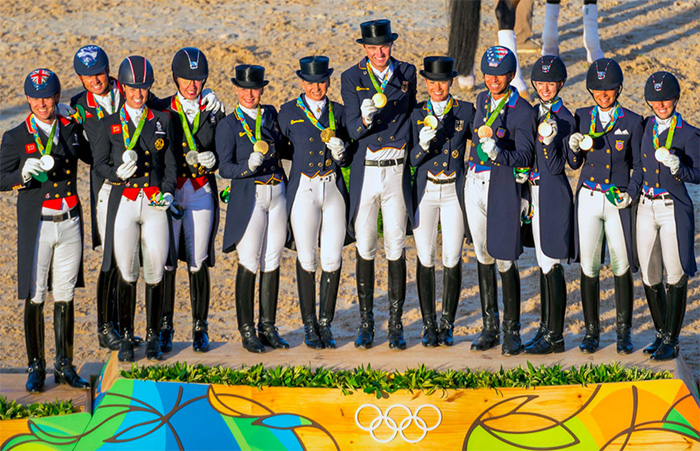

Join us on the sidelines at Spencer’s Boneo Park clinic at the Australian Dressage Championships.
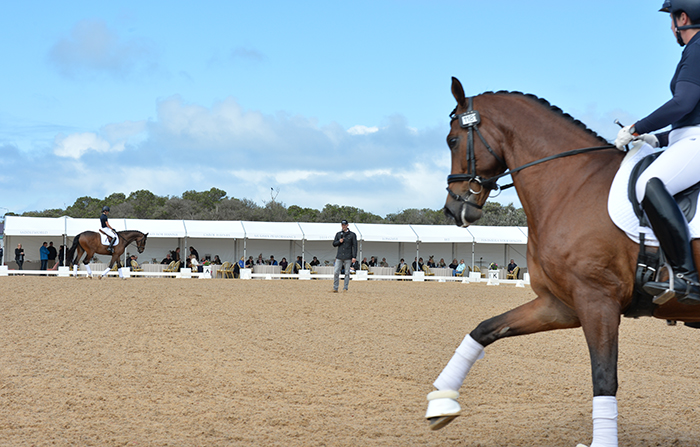 Spencer opens his session working with Denise Rogan’s four-year-old, Legendary, and Emily McQueen’s five-year-old Mayfield Whist. Right from the start, Spencer’s was a clinic with a difference: he had his own set of quite distinctive exercises.
Spencer opens his session working with Denise Rogan’s four-year-old, Legendary, and Emily McQueen’s five-year-old Mayfield Whist. Right from the start, Spencer’s was a clinic with a difference: he had his own set of quite distinctive exercises.
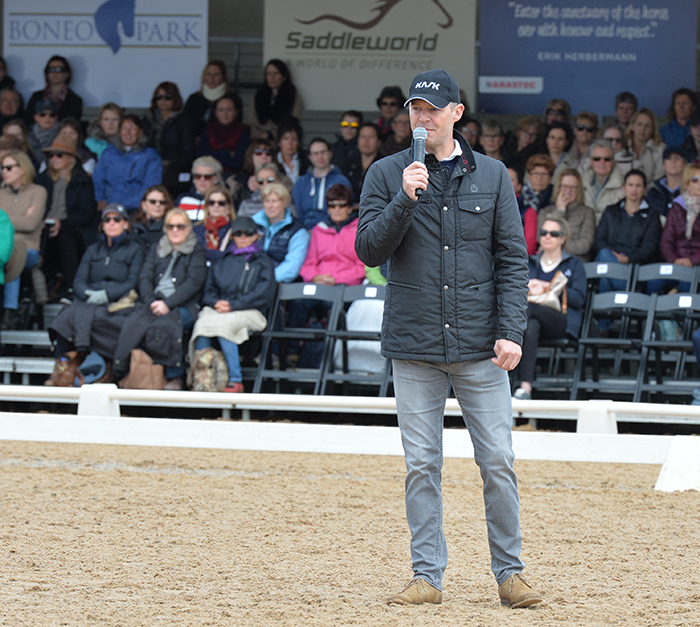
“These are exercises that I use all the time, and we’ll start with one of my favorites, it’s a leg yield to the quarter line and into renvers, and so this you need to be quite specific with the lines and angles.”
“The big thing is the move of the hindquarters into renvers position, and keeping the horse’s face square to the short side.”
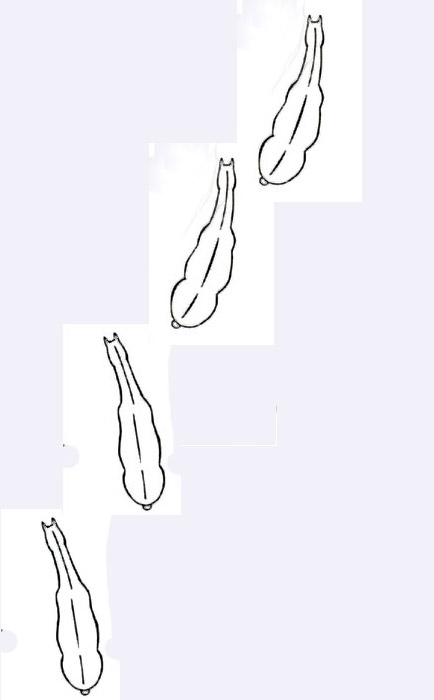
It looked like this, leg yield from the long side to the quarter line, then along the quarter line towards the short side in renvers:
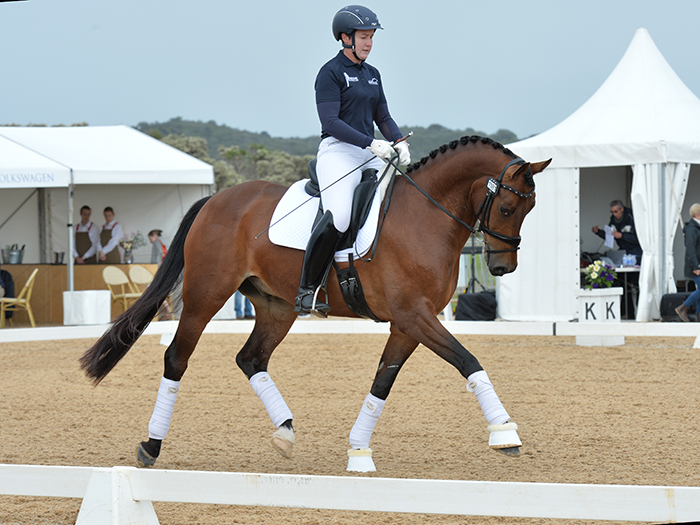
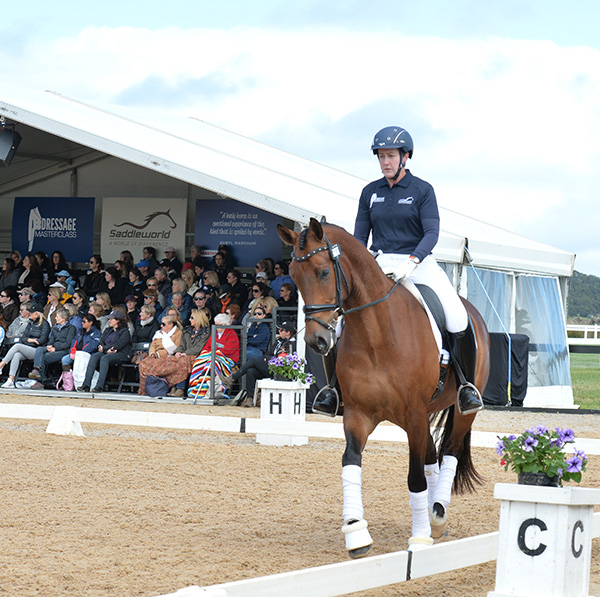
Spencer was firm that the riders should do the exercise on both reins.
“We all have a big task and that is to maintain the symmetry in the development of the horse, and this is often something that trainers don’t give enough care and attention to.”
After the clinic, Spencer was happy to discuss his exercises:
Watching your clinic was interesting, I’ve seen a lot of jumping clinics with George Morris, and George has a series of exercises where the exercise itself teaches the horse, and you seem to have the same for dressage…
“So many of the exercises that I use I am really trying to get the riders to feel and to think about how the horse is working and how the horse is using itself, and how they can encourage them to use themselves in a different way. So yes, you are right, that’s how the exercises work, but at home, when I am working one-on-one, I would be spending more time getting the rider to really understand what’s going on underneath him, and how it’s going on.”
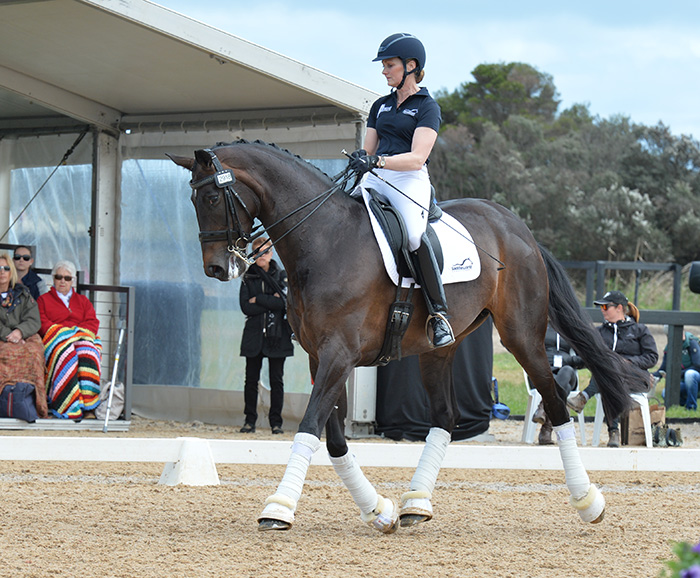
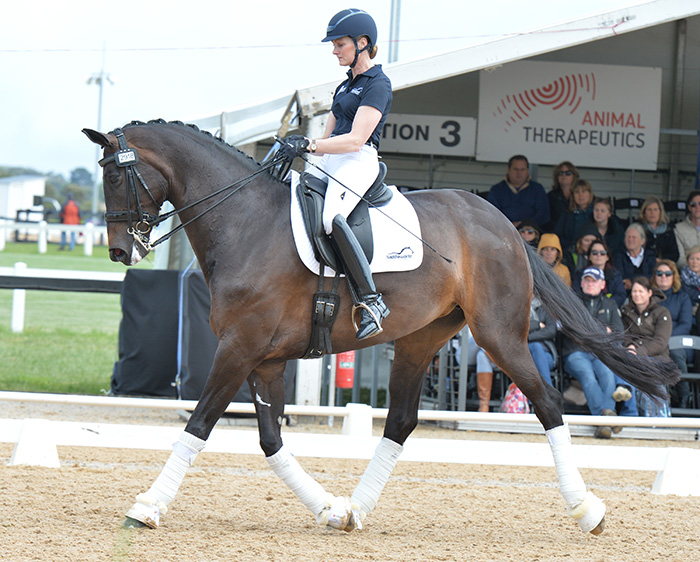
Maree and Donna Elena demonstrate
More follows…
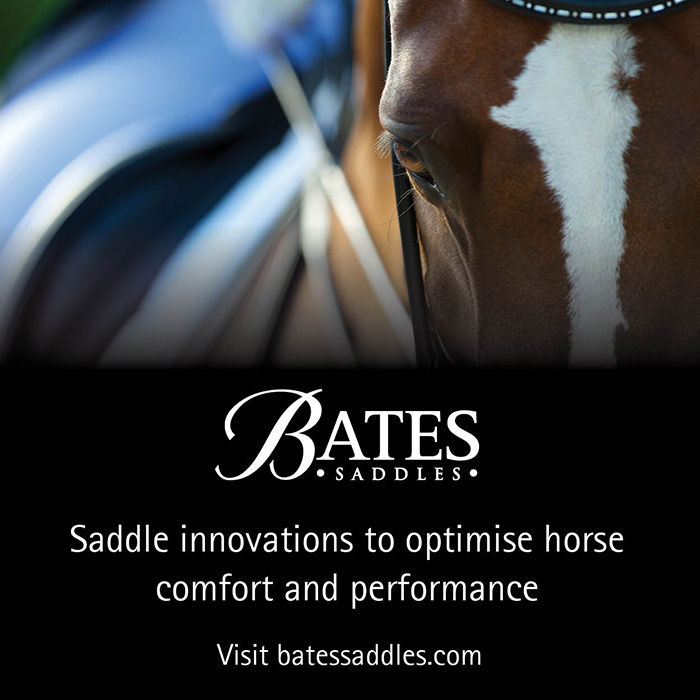
How did you develop the exercise that you used today, your leg yield to renvers exercise?
“I just made it up one day. I used it actually on Super Nova originally. I hate riding travers and renvers, it always feels like such an awkward movement for the horses to do, until you get on one that does it really well, and then you think, well actually this is doing something. So then I got to thinking, how when you are teaching a horse travers and renvers, how do you do it? And I hate doing it on the wall because I think that even if you are incredibly disciplined, psychologically that wall is there… So that exercise just happened one day. I don’t think it is going to change the world, but it feels nice and I use it to develop the trot and get more engagement. With the more advanced horses it is that moment of changing from the leg yield to the renvers, that really gets the hind leg doing something a bit more special.”
“I start a working session with the renvers exercise to get the horse to accept your leg and hand. It often takes a bit longer to establish renvers on the quarter line where you don’t have the wall to help, but when you get it, it is much more genuine, and more useful when you want to train half pass.”
Once upon a time in the dim distant past, there was a school of thought that said any leg yield was an abomination and heresy against the classical principles – how they would cry – can you teach half pass after you have taught leg yield…
“Horses in an ideal world should be able to do what you want, when you want it, in the nicest possible way. I missed the ‘no leg yield’ memo I think. I find leg yield a very valuable thing to do, and so far I don’t think it has had a detrimental effect on what I’m doing – but I might be wrong.”
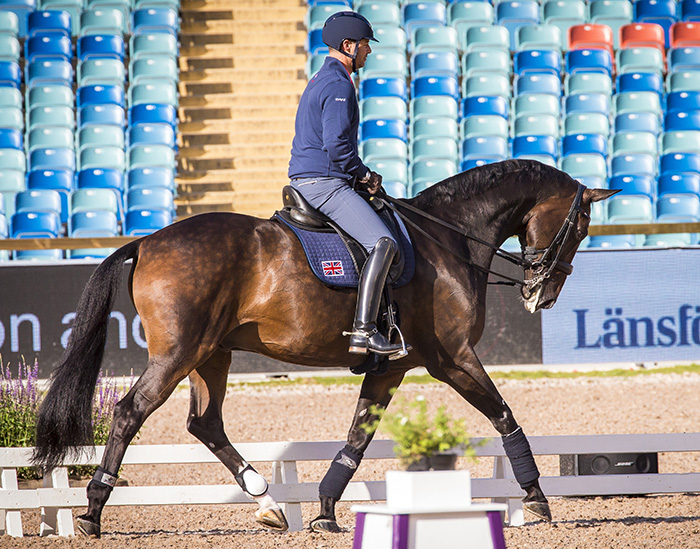
Spencer and Super Nova on warm up day at the Euros in Gothenburg
Spencer was entirely un-strict when it came to the dreaded question of where the horse’s head and neck should be:
“Me, I ride in all different types of outline. With young horses you try to find an outline where the horse feels comfortable, for some it is more down, for some it is more up. When you have a good connection from the leg to the hand, you can put the neck anywhere. Wherever you feel the best connection, that’s where they should be. Don’t worry about where the nose is, but worry about the shape of the neck. If you have a really nice shape and arc to the neck, but the nose is slightly behind the vertical, that’s something you can work on. Obviously when the horse gets older and stronger, they can go into a more advanced outline.”
More follows
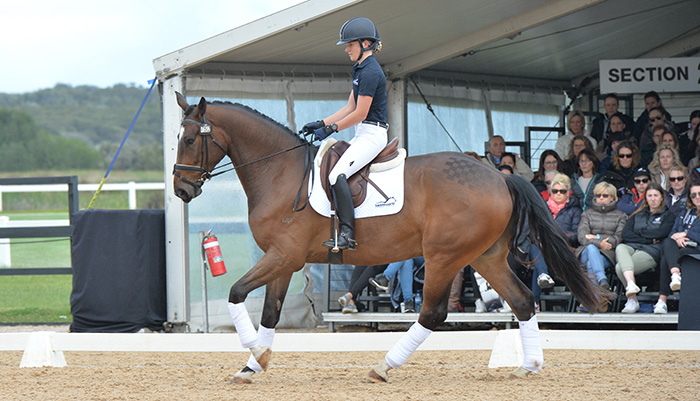
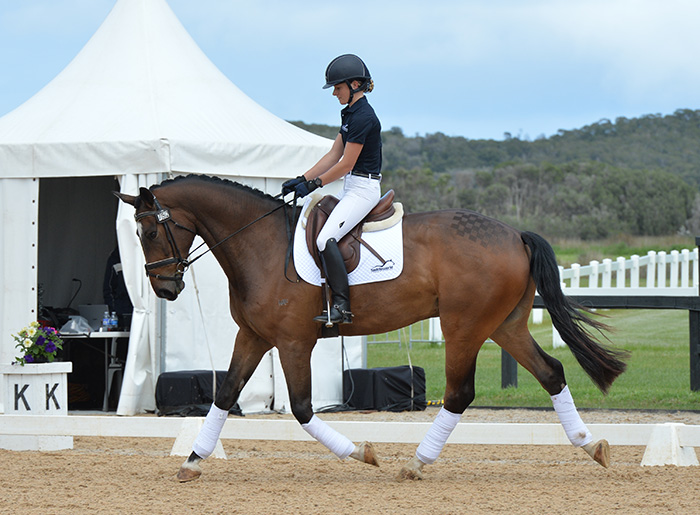
Emily McQueen and Mayfield Whist practise canter trot transitions
Spencer also wanted the riders to work on their canter / trot transitions: “It is an under-used transition – remember you will still have to ride the horrible canter / trot transition in the Grand Prix when you get to that level. Make the transition simple, just stop riding canter, go a bit floppy and use your voice.”
“Be really fussy about circles – often after a canter transition, it takes two or three strides to find the circle. NO, know where you are going.”
Looking at the riders in his lesson…
“Emily needs a more consistent, even contact – not stronger, not rounder, but more genuinely accepting the bit. She has nice soft hands but I see her fingers opening and the rein is going to slip, and get longer.”
“Denise’s young horse is getting a bit tired and the trot is getting longer and the hind legs dis-engaged. Do some walk / trot transitions to put him together again. Now ride him on the other rein to be aware of the symmetry and, if nothing else, to make you aware of which bits need work to make them supple.”
“In everything we do, we are trying to work on the connection, leg to hand. Some of the work at the beginning may seem quite tedious, but it is so important to be really fussy about the small details, gentle repetition, and lots of walk breaks.”
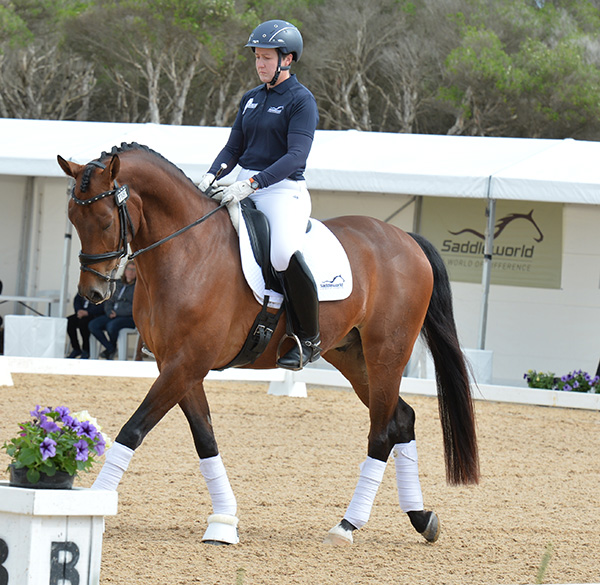
The next two horses were older and more advanced, John Thompson and Balzac and Rachelle Wilson with the seven-year-old, SPH Donna Cara. Spencer had another of his exercises in place, a canter figure eight across the short side, asking first for a simple change.
story continues below the advertisement
John and Balzac demonstrate the exercise with a flying change.
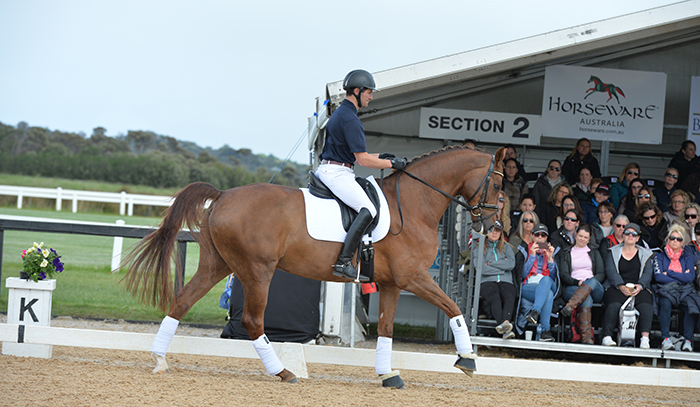
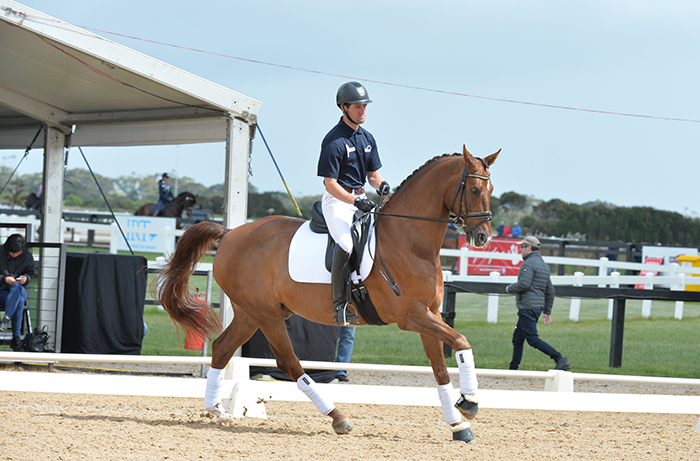
Tight turn using the hind legs, setting up the change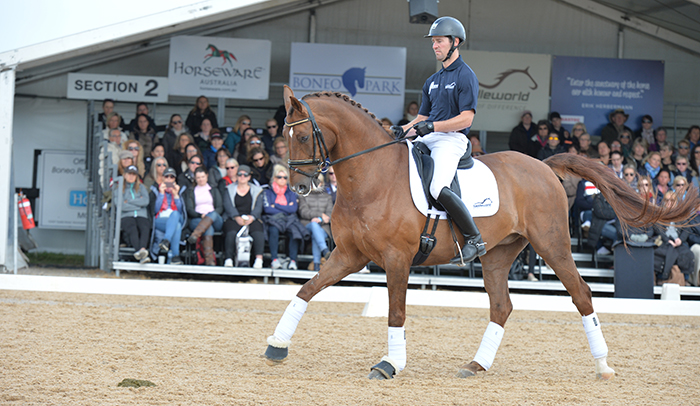
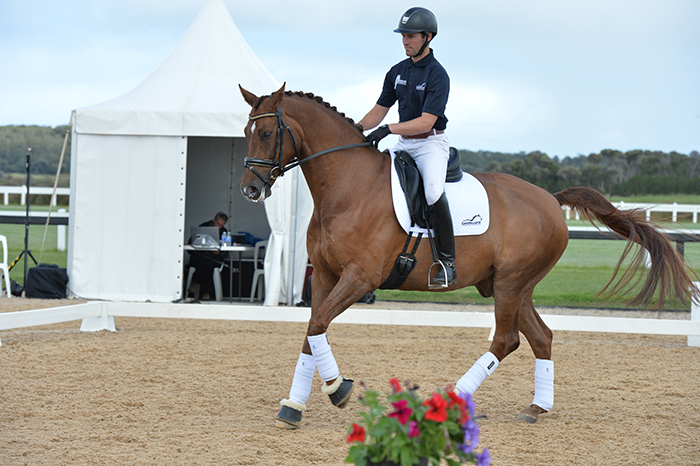
“It’s important on the diagonal line to position the horse in a shoulder fore position, neck straight and the shoulders in the new direction. The idea of the tight turn is that using the hind legs, you are setting up the simple change, and later, the flying change. There is a lot going on in a short time, it’s really useful for the canter. Once they know the transition to walk is coming, embrace the anticipation and use it.”
Balzac wanted to try flying changes…
“No ride some more simples. We are trying to micro-manage the last few strides, it is important the horse knows the change is coming, but is waiting on the rider’s aids.”
Simple change established, time for the flying change, and again, Spencer wanted to the horse to be thinking ahead:
“When we are trying to create big, open, expressive changes, it is important that the horse knows the change is coming.”
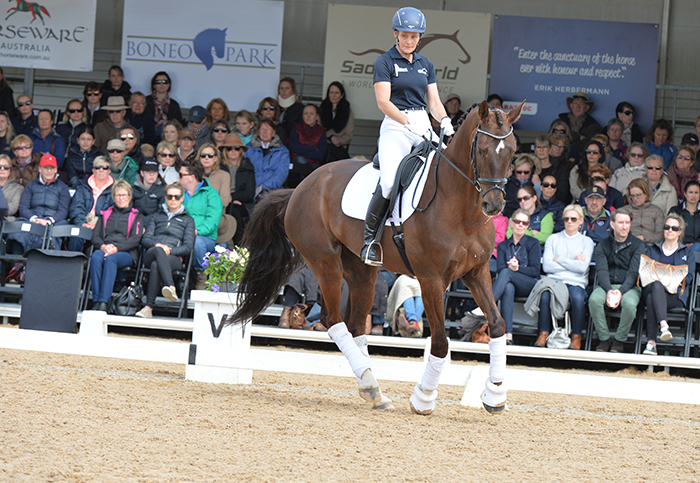
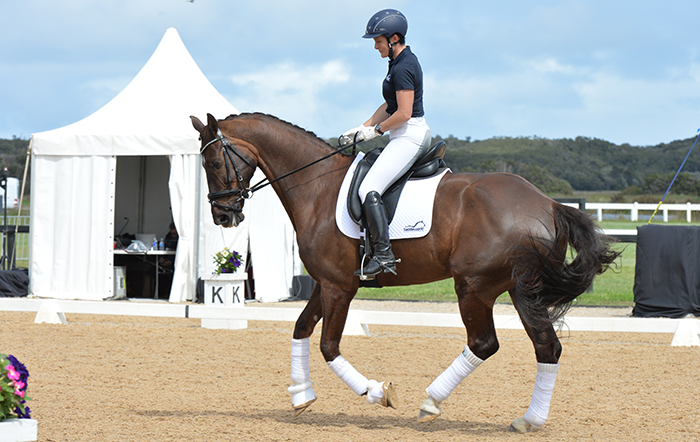
Rachelle and Donna Cara ’embracing anticipation’.
Spencer elaborated afterwards:
Your figure eight with your change of flexion as you went in the direction of the short side was this another blinding flash of inspiration…
“I’ll tell you what it was – years ago I had a horse that was particularly difficult with the changes, it would change early, ahead of my aids, anticipate and then, the changes were late behind… So I just felt that if I put the shoulder there and I had my new inside leg holding the horse in that position, I could micro-manage those last few moments, in order to get the change clean, when I wanted it. At home, when I’ve got time to really pull the exercise apart with clients, it’s such a multi-layered exercise. Again, it is getting the rider to understand how they can… manipulate is not the right word, but how they can mould the horse into positions. I don’t teach hundreds of Grand Prix riders, I teach a lot of lower level riders that are on a journey of development, and learning how to coordinate their own bodies, so that they can get the horses to coordinate their bodies. It is a way of trying to get that across to them.”
The other heresy that you were putting forward at that point was embracing anticipation! Ye gods, anticipation is the worst thing you can let happen…
“No, no, no, not at all. Letting it happen, yes that is bad, but using it is another thing. For me, a horse that anticipates is thinking forward, it is a horse that is thinking ahead of itself, and I think that is showing intelligence. I think the horse that anticipates is a much easier horse to train than one that doesn’t – for all sorts of reasons.”
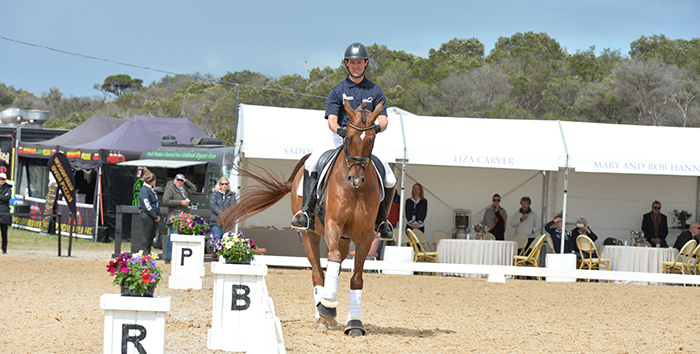
Spencer then had John riding his changes on the long side:
“We want to see how the horse responds to changes without a change of direction. Ride a tiny bit off the track. We don’t want to take away from this horse’s youthful enthusiasm, but at some stage he will have to be more under control. Think about the stride after the change.”
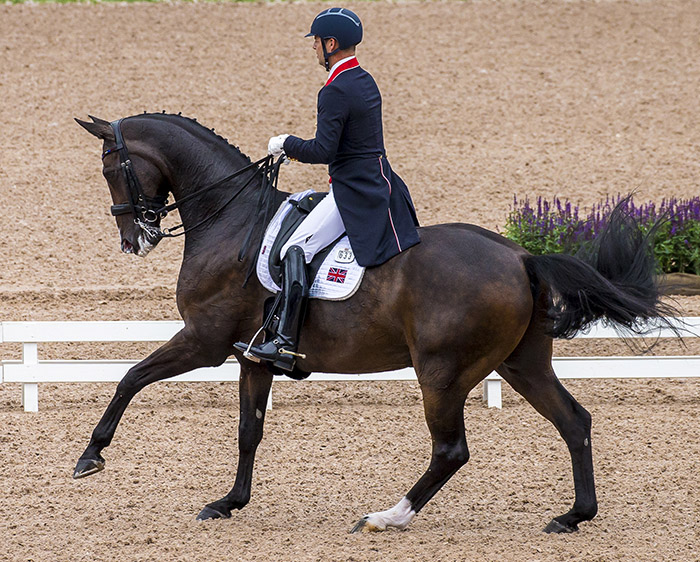
Spencer and Super Nova at the European Championships
Spencer has another young horse in his final session, but while Maree Tomkinson’s Donna Elena may only be 7 years old, she is already comfortable with some of the more advanced movements.
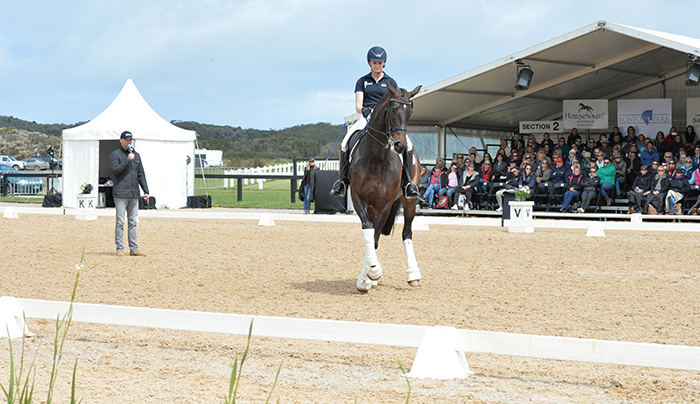
“This mare can do some fancy tricks. Is she too young? No, because she does them so easily.”
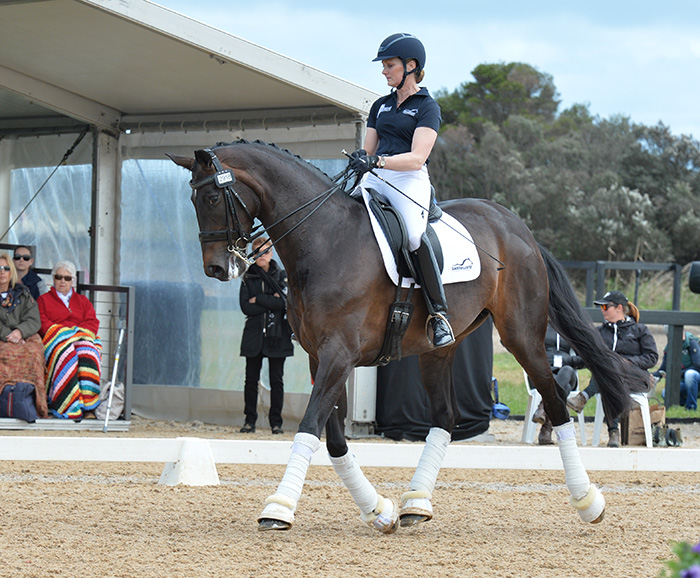
Once again, Maree and Donna were asked to ride the leg yield / renvers exercise:
“With the more advanced horses it is the moment of the transfer of the leg from leg yield to renvers, that engages the hind legs, so they are really crossing over. Let the exercise do the work for you.”
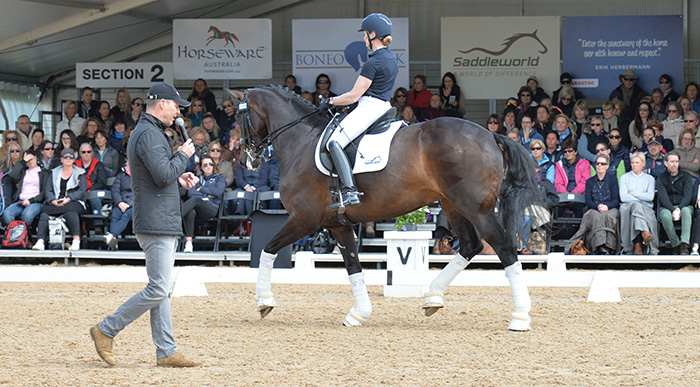
“Now we can work on the half pass. Although the horse is asked to go sideways, the emphasis is still on forward, the inside hind leg is getting the horse forward, and the outside hind leg, getting her across. Go down the centre line, at X half pass to the long side. As it becomes more easy, you can make it more parallel.”
It was time for a canter exercise on a circle, using the leg yield travers exercise again:
“For younger horses, this is a suppling exercise, for the older ones, it is working towards pirouette. Ride travers on the circle, keep the quarters towards me, then straighten, leg yield then back to travers.”
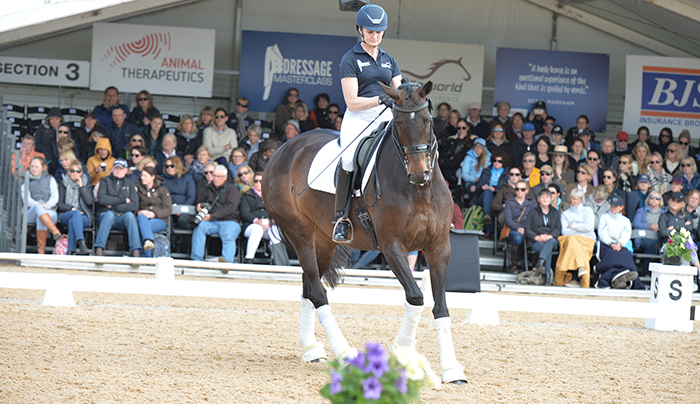
“Now spiral down the travers, set her up and let the exercise do the work. As soon as you feel her taking over, ACT, get out.”
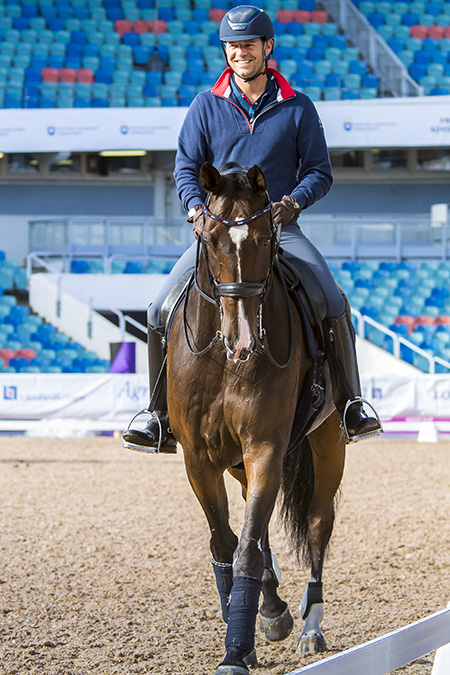
It was another fascinating session from a rider who has been a key player in the emergence of British dressage…
next we speak with Spencer
Looking at your equestrian education, who were the main influences for you?
“Obviously I spent thirteen years with Carl Hester…”
That’s a fairly strong influence…
“He is a strong influence, I learnt a huge amount. We were working together in a very interesting time, in that it was before he had hit superstardom with Charlotte Dujardin and Valegro and so on. So he was finding himself a little bit in those years, and I learnt a huge amount, it had a massive impact on me.”
“I love watching other riders and seeing how they warm up and their ideas about riding. I am fascinated by Isabell (Werth). I could watch Isabell for days upon days upon days… There are some really wonderful riders out there and I love watching and learning.”
What is it about Isabell that gets you in – aside from her stare…
“I love the stare. I think her timing is impeccable, I don’t think there is anyone quite like her. If you look at all the top riders, they’ve all got different styles, and lots of that is to do with their body shape, size and strengths and weaknesses. The thing that fascinates me about Isabell, and it is such a simple thing, but every horse I see her on, no matter how hot and electric they are in the piaffe and passage, they all walk. She drops the reins and they walk. You don’t see that often, that electricity one minute, then boom – walk, then it’s back again. I think that is remarkable. I don’t think there’s any other rider in the world that you can say that about – all her horses walk, every single one. It’s fascinating.”
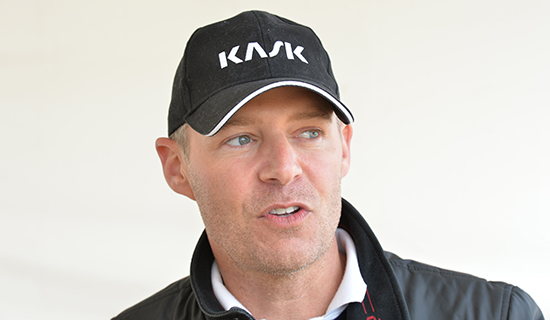
Lief Törnblad remarked the other day, that he thought that Isabell had changed over the last ten years, that her riding had become softer as part of the swing to more harmonious dressage…
“I couldn’t really comment on that because I’ve only been watching her closely over the past few years, but I am sure that as the sport changes and evolves, to stay at the top, the riders have to change and evolve, they can’t stay stuck in a form that is not adaptable because they’ll be left behind.”
Looking at your clinic, it seemed it was like all good riding, doing simple things perfectly…
“Absolutely, the small details are so important and they are over-looked in the name of expression and excitement and all the rest of it. Actually dressage is easy if they are on the bit…”
And it is surprising how many of them aren’t…
“I know, I know. It sounds like a stupid thing to say but it is so simple if they are connected and on the bit, it is not complicated, but it is the getting them on the bit and the getting them connected that takes work – so I am always trying to encourage the people that I train to ask themselves – are they on the bit? Or are they in an outline? And they are two very different things.”
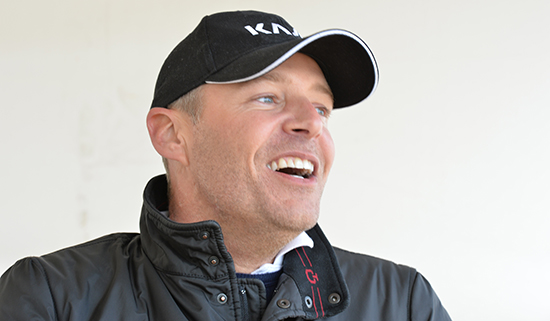
But when that does happen, the rider gets an instant reward, it is so much easier to sit, suddenly the horse’s back is soft – it must be awful the people who train their horses through tension, every working session must be so painful…
“I know with my horse in particular because he’s had soundness issues historically, touch wood he’s been very sound for the past few years, but I can’t work him and work him and work him, I have to make every step and minute count. That’s been an interesting journey for me and it has made me realise that you don’t have to train hard – and I don’t think it works. He’s probably my horse of a lifetime and I want to try and make him last as long as I possibly can.”
What is his mission, Tryon?
“Yes. So I’m not going to do any indoor shows with him this season. I tried to do Stuttgart last year and he is just too sensitive for those big indoor shows. It was a big mistake and I am annoyed with myself that I did it, but I thought at 13, and having done the Olympics, we might give it a go. But I was wrong. I’m going to keep him outdoors and not do any winter shows. Hopefully start in Doha in March – which he did this year – and although it’s an indoor, it is like being outdoors. Then Compeigne, because I love Compeigne, it’s a great show, and then I was thinking to myself that Tryon is going to be a big atmosphere, and historically I’ve kept him away from big atmospheres until we’ve got to a Championship – so I might be brave next year and do Aachen! It’s a risk, but we’ll see, I might still change my mind.”



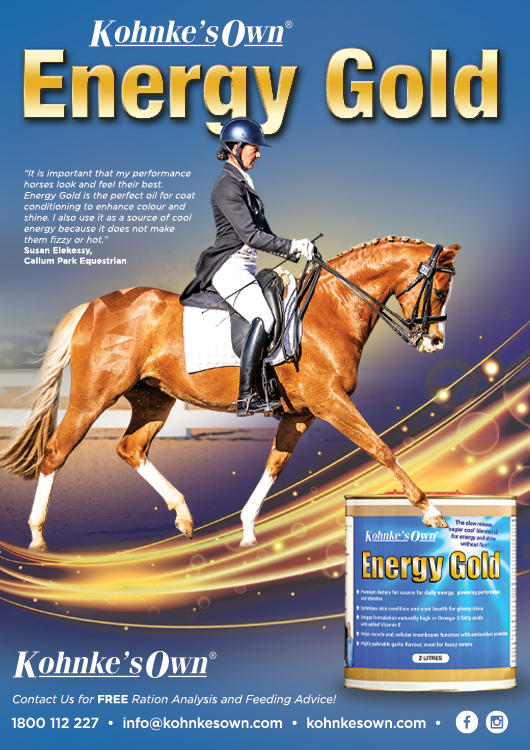
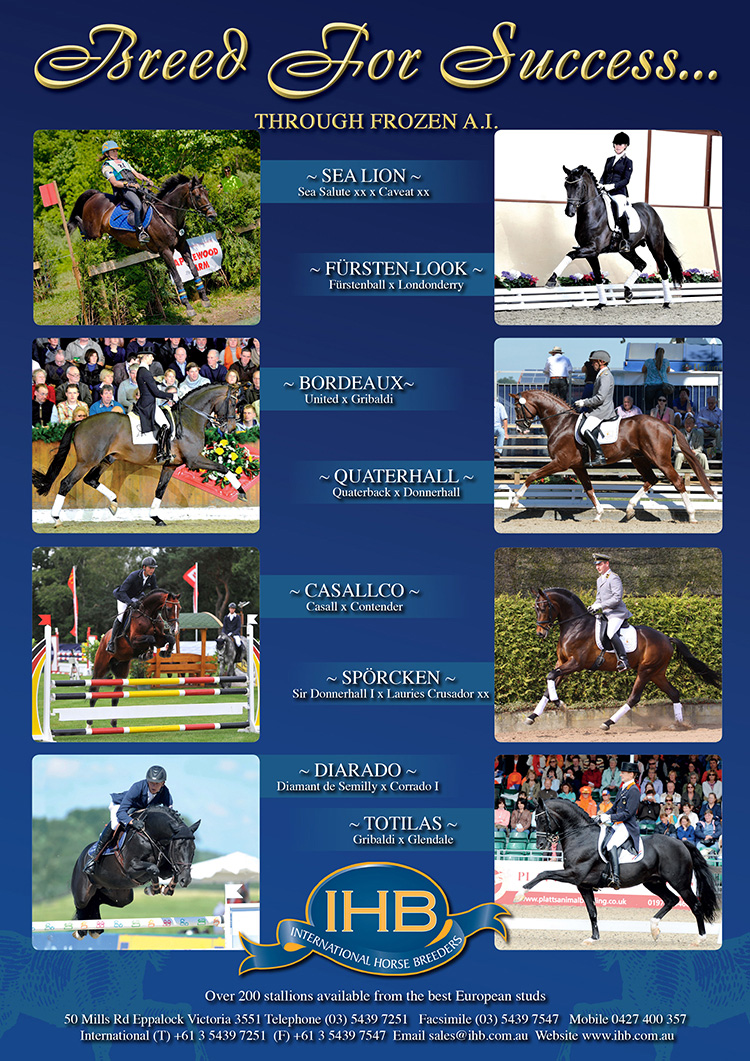
I was at the masterclass and I though he was saying his exercise was leg yield into travers ??? He was saying for it not to be a correct leg yield but to let the shoulders fall out a bit and the hindquarters trailing a little, then with the riders outside leg back the horse was already in travers position???
Made more sense to me for the later exercises than to be in renvers!!!!!